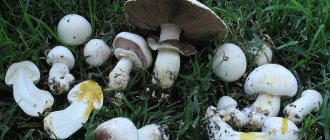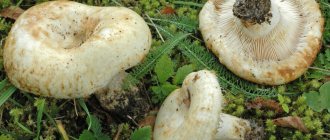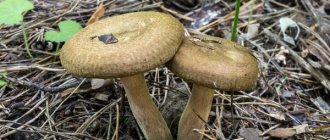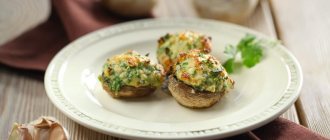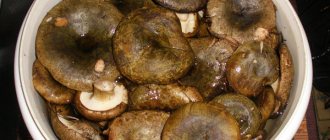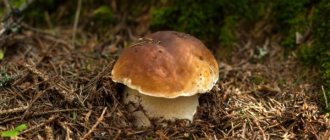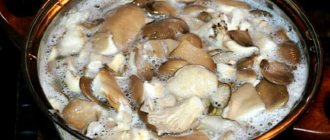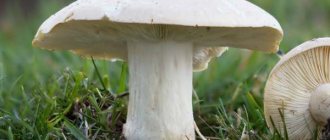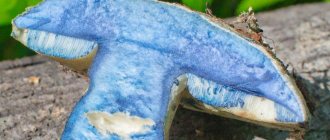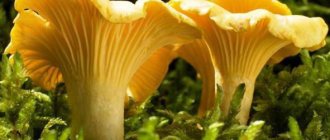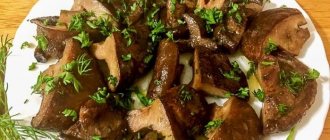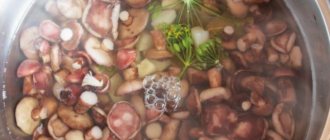October 10, 2022 ditim Home page » Reading Views:
In our family, grandmothers traditionally pickle mushrooms. They know the proportions, and their hand is already, as they say, “full.” But a couple of times my husband and I had to salt mushrooms . The fact is that we collected a lot of mushrooms, and we urgently needed to process them. The first time it turned out great! But the second time the mushrooms became moldy, cloudy, and sour . Now we know our mistakes and are happy to share our experience in this article.
Why did milk mushrooms in jars become moldy on top and how to preserve mushrooms
For any gourmet, crispy salted milk mushrooms are a real pleasure. However, not everyone knows the secrets of properly salting or marinating mushrooms, as well as their subsequent storage. Very often a problem arises if mold appears on the milk mushrooms in the jar.
How to properly preserve salted milk mushrooms sealed in jars from mold? If mold appears on mushrooms, there may be several reasons:
- poorly sterilized container;
- the temperature regime was not maintained during the salting or marinating process;
- mistakes were made in the recipe, for example, not enough salt was added;
- There was not enough liquid in the jars and the mushrooms were not completely immersed in it.
When milk mushrooms in a jar became moldy, it was possible that not just one factor was at work, but several. However, you should not be afraid of this, because the situation can be saved. You shouldn’t throw away the milk mushrooms at all, but you also shouldn’t let the problem take its course. If you delay for a long time in correcting the situation, you may end up having to throw away the preparation, since both the taste and smell of the mushrooms will suffer. As soon as it is noticed that the milk mushrooms are covered with mold on top, take immediate action.
- If mold is visible only on the surface of the brine, carefully remove the top layer of milk mushrooms.
- Drain all the brine and rinse the mushrooms several times.
- Fill with water and boil for 15-20 minutes over medium heat with the addition of salt (take 2 teaspoons of salt per 1 liter of water).
- Sterilize new jars and lids thoroughly.
- Prepare a new brine or marinade and pour over the mushrooms.
If, nevertheless, mold has penetrated below the top layer of mushrooms, throw away the workpiece and don’t think twice about it. You should not spare your efforts, because if you eat milk mushrooms with mold, there is a risk of serious poisoning.
Answers to common questions
When identifying mold on salted mushrooms, housewives may have many questions. The most common ones are discussed below:
Proper preparation and storage of salted mushrooms will help preserve the taste of this snack for a long time. If mold does appear, do not rush to throw away supplies. In most cases they can be saved. To do this, it is necessary to immediately carry out a number of specific actions. If mold is not detected in time, the supplies will have to be thrown away. Eating spoiled foods can be harmful to your health.
Any type of spoilage: mold, fermentation, unpleasant odor - this is the strongest poison on mushrooms, both salted and pickled. You shouldn’t feel sorry for them and try to somehow revive your favorite product. Throw it away safely, because by doing this you will save yourself and your loved ones health, and possibly life.
Next door to our friends lived an elderly woman whose grandchildren came to see her for the New Year and she opened a jar of pickled mushrooms for the table. In the morning, all three (the grandmother and her two grandchildren) were found dead. The mushrooms were spoiled, but the woman either did not notice this or did not attach any importance to the unpleasant smell.
Health and life are more valuable, so it is better to throw away suspicious mushrooms.
Definitely throw away the pickled mushrooms, otherwise they will do nothing but harm. If the mold is only on the surface and has not penetrated deep into the mushrooms, then the salted mushrooms can be washed, brought to a boil, drained of water, pour new hot (not boiling) brine with the addition of spices - garlic, more salt, dill seed, etc.
If the mold has penetrated to a great depth and a persistent moldy smell remains, then such mushrooms will retain the smell even if you boil them. In this case, it is also better to throw away such mushrooms.
If there is a large thick black film of mold on the mushrooms, then take them out and throw them away so that mold spores do not rise into the air and get into your lungs. This is dangerous.
To prevent mold from developing on mushrooms, I pour boiled sunflower oil into a jar with mushrooms, it creates a film where mold does not penetrate.
Proper preparation and storage of salted mushrooms will help preserve the taste of this snack for a long time. If mold does appear, do not rush to throw away supplies. In most cases they can be saved. To do this, it is necessary to immediately carry out a number of specific actions. If mold is not detected in time, the supplies will have to be thrown away. Eating spoiled foods can be harmful to your health.
What to do if home-picked milk mushrooms become covered with a white coating?
Causes of mold
Salted mushrooms can become moldy for various reasons. Here are the main ones:
- Insufficiently sterilized container. If you do not prepare the jars for pickling, there is a high risk of mold development.
- Too little salt and spices. You need to add them to the twist strictly according to the recipe.
- Incorrect storage conditions. If the temperature in the room where the supplies are kept is too high, this will accelerate the growth and development of pathogenic microorganisms.
- An incompletely filled jar. The air that remains in it promotes the development of mold. The brine should be poured into the container to the very top.
If one of these rules is violated, mold fungi will begin to develop in the jar containing the product. Their color may vary. Light mold is considered the safest, so the pickles can be saved.
The appearance of black mold requires disposal of the twist. Its spores can penetrate the lungs and cause great harm to health.
What's normal?
First, let's turn to traditional Russian recipes for pickling mushrooms and see how it's done correctly . After all, if you compare your actions with the ideal, mistakes will immediately become visible!
There are two types of mushroom pickling: cold and hot .
1. Cold salting. The mushrooms are cleaned of debris, filled with cold, unboiled water and left for 2-3 days in a cool place (16-18 degrees Celsius). The main condition: the water needs to be changed 2 times a day so that the mushrooms do not turn sour. The soaked mushrooms are washed and allowed to dry. Sprinkle the bottom of a clean dish with coarse salt, and place mushrooms on it, caps down. Width of one mushroom layer: 5-7 cm. Amount of salt: 30-50 g (1-2 tablespoons) per 1 kg of mushrooms (which approximately corresponds to 1 liter). The layers are laid one by one, sprinkling each with salt and placing currant leaves and dill umbrellas between them, to the very top. The last layer is covered with currant leaves and a clean, thick cloth. All this is pressed down with a wooden circle and oppression (heavy stone). After 5-6 days, you need to check whether all the mushrooms are covered with brine. And after another month and a half they can be eaten.
Important! During pickling, it is important to periodically check whether the mushrooms are covered with brine or not. If it is not enough, add boiled cool water to the container. When salting using a cold method, at first it is recommended to wash the fabric daily.
2. Hot salting. Clean mushrooms are carefully transferred to an enamel pan or basin, filled with water and set to cook. There is no need to stir them until they boil. And after boiling, stir the mushrooms from time to time and skim off the foam. Cook most mushrooms before salting for 15-20 minutes, honey mushrooms and chanterelles for 25-30 minutes. After this time, they are thrown into a colander. Once the water has drained, sprinkle the boiled mushrooms with salt and place them in the same way as the cold method.
Important! If the weather is hot and there is no place with a suitable temperature (10-12 degrees Celsius), you need to add more salt - 50 g per 1 liter.
Much depends on storage conditions
It is correct to store salted mushrooms in a cool, well-ventilated place, where the mark on the thermometer does not rise above +1, +3 degrees. If the temperature is lower, the mushrooms will freeze and lose their taste, and in excessive heat (above +6 degrees) they will sour.
After finishing the salting, it is better to put the mushrooms in jars, put the spices from the bucket on top and cover with lids. The jars are stored well in the refrigerator at a temperature of +5, +8 degrees.
If mushrooms are pickled directly in jars, you should not cover them with lids, only with a cloth. To allow air to enter, densely packed mushrooms are pierced with a stick to the very bottom, like sauerkraut. With access to air, the development of botulism is impossible, which is very important when preparing products that have come into contact with the ground.
A wooden barrel or enamel bowl is more suitable for pickling mushrooms. You also need a dark, cool place where the mushrooms will stand throughout the pickling period.
In hot weather, if there is no cellar and there is no cool place in the house, the hot salting method is most relevant. When cold salting, there is a high probability that the mushrooms will sour even at the stage of soaking in cold water.
That time, when our mushrooms turned sour, we did hot pickling .
What to do if the pickled milk mushrooms are too salty?
Pickled or pickled milk mushrooms that are too salty can be soaked in cold water for 2-3 hours before eating. In this case, the water should be changed every 30 minutes. Then place the mushrooms on a wire rack or sieve and leave to drain thoroughly.
Next, you can make a cold appetizer from the soaked mushrooms by cutting them into pieces and seasoning them with vegetable oil, onions or green onions. You can add chopped dill and parsley, mix and safely serve. You can be sure that guests will not notice anything.
Sometimes some housewives feel like they have over-salted marinade in their mushrooms. What to do if you over-salt the milk mushrooms in the marinade?
- You need to take a small piece of cloth and pour 1 tbsp into it. flour and tie tightly with strong thread.
- Place in boiling marinade and leave for 10 minutes. The flour will be able to absorb excess salt, then the marinade will acquire an excellent taste, and your mushrooms will be saved!
Some housewives prepare a vinaigrette from salted mushrooms, adding boiled and chopped vegetables. It turns out to be quite a tasty and spicy dish with salted mushrooms.
Processing moldy mushrooms
To save moldy mushrooms, you need to:
rinse the remaining mushrooms in salted water;
Washing mushrooms
Re-marinating
To prevent mold from occurring again, you need to add a large amount of spices, garlic, dill or horseradish leaves to the brine. You can also put chopped horseradish root on top and pour vegetable oil over it. It is important to monitor your supplies so you can spot mold growth in time.
If you use the salting method under pressure, it is necessary to disinfect the load or plate. To do this, rinse them thoroughly in warm water, then scald with boiling water. Every week you should change the saline solution, disinfect the load and wipe the top edges of the dishes with a cloth soaked in vinegar.
Is it possible to eat salted milk mushrooms with mold?
Mold requires oxygen to grow. Therefore, mushrooms grow mold first of all in the place where there is direct contact of the fruiting body with air. As a result, the fruiting bodies turn black and a greenish-white coating appears on their surface. They cannot be eaten in this form. The deeper layers of the caps, hidden under the thickness of the brine, become moldy much later. If the milk mushrooms are moldy on top, then it is necessary to get rid of the entire top layer that has traces of damage. There may well be absolutely normal salted mushrooms underneath. If you carry out a series of manipulations with them, then they can be eaten without any danger.
Mushrooms severely affected by mold have only one way - to the trash heap
Important! If black mold appears on milk mushrooms, you should avoid eating them. Such blanks must be thrown away.
Rules for storing salted fruits
To prevent mushrooms from molding in a jar or other container, certain storage rules should be followed. Firstly, the containers in which supplies will be stored must be sterile.
Jars must be sterilized, and pots, buckets and barrels must be thoroughly washed, scalded with boiling water and dried. If you do not sterilize the dishes well enough, the supplies will spoil even if other conditions are met.
Finding appropriate storage space is equally important. It should be fairly dry and dark. The room temperature should not fall below zero and rise above 6°C. If the temperature drops below zero, the products will freeze, become brittle and lose their taste. If the temperature is too high, mold may begin to grow.
If there is no appropriate room, then supplies can be stored in the refrigerator. You can also store pickles on a glassed-in balcony. To do this, the cans must be placed in boxes and insulated using old blankets, batting, wood shavings, sawdust, etc.
It is important to use the correct storage containers. You can use containers made of enameled metal, glass and wood. Clay, galvanized tin, aluminum or plastic utensils should be avoided. Do not cover the product with a bag, cling film or parchment paper, as this will create an ideal environment for mold to grow.
Mushrooms are highly valued in cooking; they have a unique aroma and taste. One of the most popular ways to prepare mushrooms is to pickle them. But a common problem is the appearance of mold areas on mushrooms. If salted mushrooms become moldy, then do not be upset - in most cases they can be saved, because there are several ways to do this.
Moldy pickled fruit bodies should be thrown away immediately. They should not be eaten as botulism bacteria may begin to develop in tightly sealed jars.
How our mushrooms became covered with mold
We cooked the mushrooms (volnushki and black milk mushrooms), washed them, and left them to drain. Then they placed the mushrooms in an enamel bucket in layers, sprinkling with salt at the rate of 1 tablespoon per 1 liter of boiled mushrooms. This is the dosage of our woman Tanya. I can assume that in our case more salt could have been added (as recommended in the source above). The autumn turned out to be warm and sometimes it was too warm on the balcony, and in such conditions the authors of the articles advise increasing the proportions of salt.
They covered the whole thing with a cloth, put a clean plate upside down and pressed it with a stone.
After a few days, the mushrooms fermented and became moldy, and they smelled unpleasant. My husband and I decided to boil them again. The entire salting procedure was done from the very beginning (it was also recommended in the literature), but nothing helped. Soon the mushrooms turned sour again. So they threw it away because they were afraid to eat it - mushroom poisoning is one of the worst. Why risk your health?
Since then, we have not taken corned beef from the forest and have not salted mushrooms.
What to do with mold on salted milk mushrooms
Having discovered that the salted milk mushrooms have become moldy, you need to start processing them as quickly as possible. In this case, most of the household supplies will most likely be saved. The top layer of milk mushrooms, on which there is blackness and obvious traces of mold development, should be thrown away without hesitation. If underneath there are caps that are clean and have no signs of damage, then they need to be carefully transferred to another container. Since mold spores are already present in the brine, all extracted fruiting bodies must be boiled to avoid further development of the fungus.
A saucepan with selected clean milk mushrooms is filled with clean water and put on fire. To kill mold spores, simply bring water to a boil. After boiling, the water is drained. The mushrooms are laid out in sterilized containers, sprinkled with salt, and filled with fresh brine.
Boiling will kill mold spores in the brine.
Important! Along with the brine, you should add the main spices: bay leaf, dill, pepper, garlic. Otherwise, the taste of boiled milk mushrooms will be weak and watery.
It is necessary to disinfect not only the container in which the milk mushrooms are placed, but also the wooden circle and the pressure that holds the mushrooms in the brine. They are thoroughly washed from mold with water and then scalded with boiling water. The circle and oppression are installed in place, after which the container is removed for storage.
What to salt mushrooms in
As I already said, the container can be any container that is not capable of giving a chemical reaction: plastic, wooden (birch), enameled (without chips), stainless steel, glass. Do not use galvanized aluminum cookware. Any shape, the main thing is that it is stable, with smooth edges. Theoretically, you can pickle mushrooms directly in 3-liter glass jars, push a plastic lid inside, and place a weight on it. But the structure can easily fall apart and the jar can break.
Therefore, buckets, tubs, vats, and barrels are best suited. If you have few mushrooms, you can use a plastic food storage container, even a square one (the lid can be selected from a smaller container) or 2-5 liter mayonnaise buckets.
The neighbor suggested the reason
And recently we started a conversation with a neighbor in our dacha on the topic of mushrooms. She is an elderly woman, wise with experience. I told her that we don’t salt mushrooms because they turn sour. And Raisa Egorovna told what was the matter.
It turns out that mushrooms intended for pickling cannot be washed after cooking ! And we always wash all mushrooms, regardless of the purpose: be it pickling, salting or freezing.
It is logical to assume that by washing the mushrooms with unboiled water, we introduced bacteria into the pickling, which caused intense fermentation and mold.
The second reason may be a violation of the temperature regime . We placed the enamel bucket with mushrooms on the balcony, where it can be hot at times - the side is eastern, and in the first half of the day the sun warms up well even in autumn.
Thirdly, I can assume that we missed the point when it was necessary to remove mold when it first appeared. The process began and there was no stopping it. Our mushrooms not only became moldy, but also turned sour.
Useful tips
There are a few simple recommendations that will help improve the taste of the product. They are as follows:
- mushrooms can be boiled for 20 minutes. Usually this is enough to eliminate everything unnecessary;
- Rice or pearl barley will correct the current situation. Place the contents of the jar in a saucepan along with the marinade. The grain is placed in a clean fabric bag, sent to the rest of the ingredients and boiled. Product components tend to absorb salt;
- housewives prefer to use them in preparing a separate dish: salad, mushroom soup, fried potatoes. But then there is no need to add salt to the food or do it in a minimal amount.
Delicious recipe! The most delicious bread in the world
And in order to avoid the problem of over-salting in the future, you need to learn how to marinate correctly. There are a lot of cooking recipes, there are cold and hot methods. You can use anyone.
Mold on salted mushrooms: What to do?
In country literature they write that the appearance of mold on the surface of salted mushrooms is normal. What to do in this case?
- The mold needs to be removed.
- Rinse the cloth that covered the mushrooms well in hot salted water. Do the same with a wooden circle and oppression.
- The walls of the dishes where there was mold should be wiped dry with a clean damp cloth.
It is believed that the appearance of mold in an acidic environment is natural, and it is harmless to humans. The fact is that during aerobic fermentation (fermentation and pickling of mushrooms as well) favorable conditions are created for the proliferation of yeast and mold.
Such mold does not harm humans, but it must be removed so as not to spoil the entire dish.
And if the mushrooms have soured, you can boil them again, but this does not always help - as in our case, for example.
